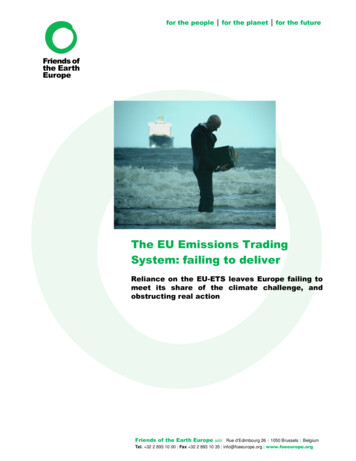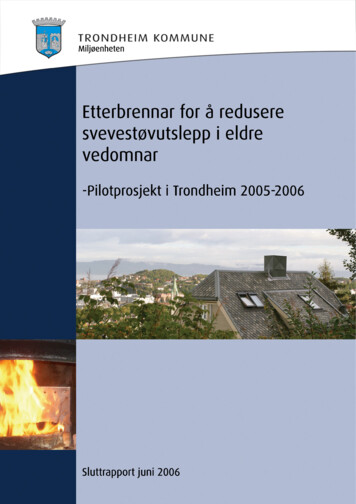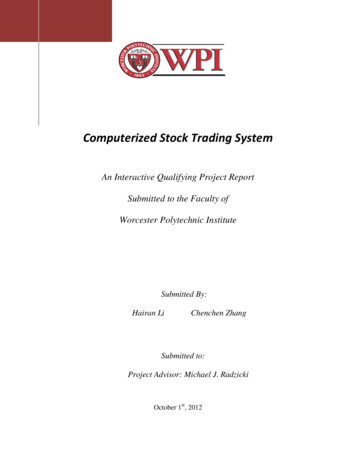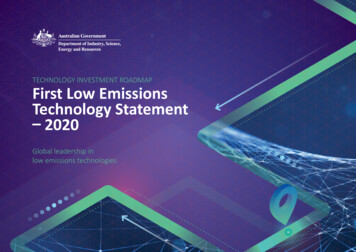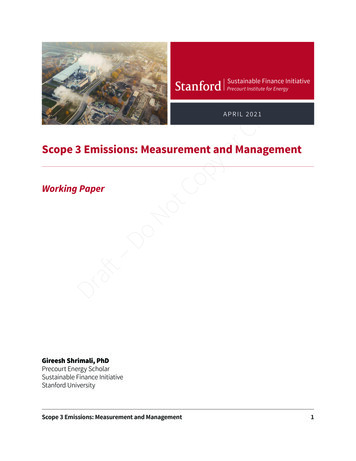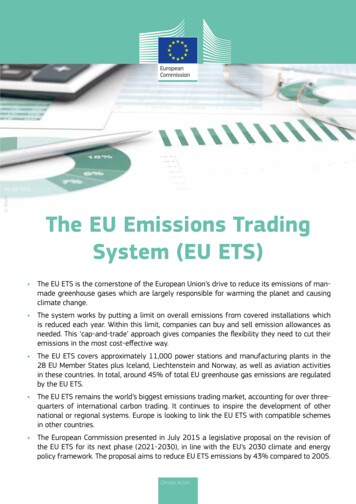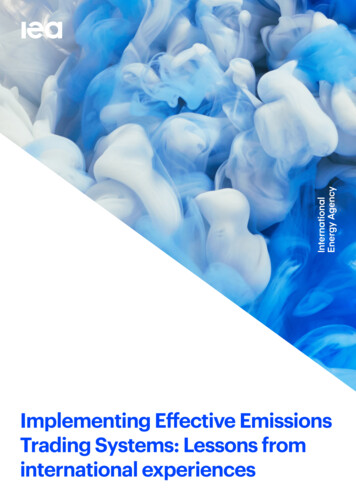
Transcription
Implementing Effective EmissionsTrading Systems: Lessons frominternational experiences
Implementing Effective EmissionsTrading Systems: Lessons frominternational experiences
Implementing Effective Emissions Trading SystemsAbstractAbstractCarbon pricing is a valuable instrument in the policy toolkit to promote clean energytransitions. By internalising the societal cost of greenhouse gas emissions, carbonpricing can stimulate investments in low-carbon technological innovations, fostermultilateral co-operation and create synergies between energy and climate policies.Emissions trading systems offer one possible design for carbon pricing schemes.Where emissions are capped, trading systems create certainty about the allowedemissions trajectory, while allowing carbon prices to fluctuate. Emissions tradingsystems create incentives to reduce emissions where these are most cost-effective.Sub-national, national and supranational jurisdictions have shown increasing interestin emissions trading systems as a policy instrument to achieve climate changemitigation goals. By analysing international experiences, this report draws lessons fordesigning and implementing effective, efficient emissions trading systems. Thereport covers structures, policies and objectives across the energy sector,elaborating key lessons and questions especially for jurisdictions interested indeveloping new emissions trading systems. This report identifies key energy-relatedchallenges drawn from “real world” experiences, opening the doors for a deeperPAGE 2IEA. All rights reserved.examination of technical issues and lesson-sharing.
Implementing Effective Emissions Trading rs and creditsThis report was prepared by the Environment and Climate Change Unit (ECC) in theEnergy Environment Division (EED) of the International Energy Agency (IEA). CarolineLee and Luca Lo Re led the report, with valuable guidance and input provided by CyrilCassisa, China ETS project co-ordinator; Christina Hood, former ECC Head of Unit;and Sara Moarif, ECC Head of Unit. Mechthild Wörsdörfer, Director of Sustainability,Technology and Outlooks, provided overall guidance throughout the project. Theauthors of this publication are Luca Lo Re, Caroline Lee, Cyril Cassisa, Zhang Weijiand Sara Moarif.Valuable contributions were also made by other current and former IEA colleagues:Peter Janoska, Andrew Prag, David Fischer, George Kamiya, David Turk, Marco Baroni,David Bénazéraf, Peter Fraser, Simon Mueller, Laszlo Varro, Aya Yoshida, MarieDesatnik Stjernquist, Hou Fang, César Alejandro Hernández Alva, Ryan Keun HyungKim, Xiushan Chen, Tom Howes, and Adam Baylin-Stern.This analysis was carried out with the support of the IEA Clean EnergyTransitions Programme. The authors would like to thank the funders of theClean Energy Transitions Programme.The authors are also grateful for valuable comments from external experts, including:William Acworth (International Carbon Action Partnership [ICAP]), Anatole Boute(Chinese University of Hong Kong), Max Dupuy (Regulatory Assistance Project),Johannes Enzmann (European Commission), Florens Flues (Organisation forEconomic Co-operation and Development), Brendan Frank (Ecofiscal Commission),Anders Hove (German Agency for International Co-operation [GIZ]), Frank Jotzo(Australian National University), Sohyang Lee (Greenhouse Gas Inventory andResearch Center of Korea), Lina Li (ICAP), Felix Matthes (Oeko Institut), Bo Shen(Lawrence Berkeley National Laboratory), Huw Slater (ICF), Kristian Wilkening (GIZ),Charlotte Vailles (Institute for Climate Economics), and Xiliang Zhang (TsinghuaUniversity).The authors would like to thank Andrew Johnston for editing this report, as well asthe following IEA colleagues from the Communications and Digital Office forproviding valuable production and publishing support: Astrid Dumond, ChristopherPape and Mao Takeuchi for administrative support.PAGE 3IEA. All rights reserved.Gully, Katie Lazaro, and Therese Walsh. Finally, thanks to Lisa-Marie Grenier, Janet
Implementing Effective Emissions Trading SystemsTable of contentsTable of contentsExecutive summary . 6Introduction . 12Carbon pricing initiatives around the world .13Carbon pricing in the public policy and private sector landscape . 15How to read this report .16Defining the role of an emissions trading system . 18Primacy of trading systems in reducing emissions .19Choosing the type of emissions cap . 24The long-term perspective: policy predictability . 25Key lessons . 27Guiding questions for policy makers . 27Managing interactions with wider energy transition policies . 29Responsiveness of an emissions trading system helps manage policy interactions.30Alignment of emissions trading systems with national mitigation strategies . 35Key lessons . 37Guiding questions for policy makers . 38Tailoring emissions trading system to power market structures . 39Power market structure can affect emissions trading system effectiveness . 39Adapting the design of the emissions trading system to power market structures .40Key lessons . 46Guiding questions for policy makers . 46Facilitating low-carbon transitions in industry through emissions trading systems . 47Emissions trading systems and industry: Context and objectives . 47Competitiveness and carbon leakage concerns for industry . 48Key lessons . 54Guiding questions for policy makers . 54Conclusions . 55Defining the role and function of emissions trading systems . 55Managing emissions trading system interactions with wider energy transitions policies . 56Tailoring emissions trading systems to power market structures. 56Facilitating low-carbon transitions in industry through emissions trading systems. 56PAGE 4IEA. All rights reserved.Abbreviations and acronyms . 58
Implementing Effective Emissions Trading SystemsTable of contentsList of figuresFigure 1.1Figure 2.1Figure 2.2Figure 5.1.Emissions trading systems (ETS) and hybrid ETS operational or scheduled forimplementation, 2020, by emissions covered .14Estimated cumulative emissions reductions due to carbon pricing in Canadacompared with other federal policies . 21Estimated cumulative greenhouse gas reductions of California’scap-and-trade system compared with those of other state mitigation policies(2021-30) . 23Phasing down free allocation as transitional assistance over time in favour ofallowance auctioning . 53List of tablesDirect carbon pricing mechanisms .13List of boxesEmissions trading system experiences in the face of unforeseen exogenouseconomic downturns . 32PAGE 5IEA. All rights reserved.Box 3.1
Implementing Effective Emissions Trading SystemsExecutive summaryExecutive summaryCarbon pricing is a valuable instrument in the policy toolkit to help accelerate cleanenergy transitions. By providing a clear signal that GHG emissions entail a cost tosociety, carbon pricing can stimulate investments in low-carbon technologicalinnovations, foster multilateral co-operation and create synergies between energyand climate policies. Carbon pricing instruments comprise carbon taxes andemissions trading systems. Carbon taxes consist of direct taxation on emissions.Emissions trading systems are market-based instruments that create incentives toreduce emissions where these are most cost-effective. In most trading systems, thegovernment sets an emissions cap in one or more sectors, and the entities that arecovered are allowed to trade emissions permits.Emissions trading systems expose emitters to the external costs of emissions in themost flexible and least costly way. The design of such a system needs to take intoaccount local contexts and regulations, as well as interlinkages with other policypriorities in each jurisdiction. This report analyses real-world experiences of thedesign and implementation of trading systems in different jurisdictions around theworld. The analysis considers the diversity and complexity of the interlinkages ofenergy policies, energy targets and energy system structures, and it identifies keyissues and common challenges that jurisdictions face when considering theestablishment of a new trading system. In addition, common challenges in tradingsystem design and implementation for the power and industry sectors are analysed.Key lessons and guiding questions for policy makers are provided to help withdeveloping and implementing emission trading systems.Carbon pricing initiatives are spreading throughout the world. Over 60 countries,cities, states and provinces have implemented or are planning to implement carbonpricing schemes, with a fairly balanced distribution between emissions tradingsystems and carbon taxes. When the trading system in China’s power sector startsoperating, carbon pricing initiatives will cover 20% of global emissions. Jurisdictionsin Asia and the Americas are now the driving forces for new carbon pricing initiatives.Role of an emissions trading systemIn defining the role of a trading system, policy makers could reflect on what thesystem is designed for and expected to do. For example, an emissions trading systemPAGE 6IEA. All rights reserved.could be intended to drive emissions reductions as its principal role, or provide a
Implementing Effective Emissions Trading SystemsExecutive summarybackstop for other policies. In practice the system may function somewhat differentlythan intended, such as a means to raise revenue for investing in further emissionsreductions projects or in sectors other than those covered by the system. Throughoutthe process of defining the role of an emissions trading system, policy makers couldalso reflect on other expected outcomes of the system, such as changing businesspractices or shifting investment decisions.Primacy of trading systems in reducing emissionsJurisdictions have implemented emissions trading systems with varied ideas of therole they will play in reducing emissions reductions. In some cases, trading systemsare seen as the principle means of achieving emissions reductions, in others as abackstop measure to ensure reductions in case other policies do not deliver. Theeffectiveness of an emissions trading system should be evaluated based on itsobjective. In the longer term, gradually increasing the stringency of a tradingsystem’s cap would contribute more to emissions reductions.Choosing the type of emissions capPolicy makers can set the cap of an emissions trading system in different ways, andthis choice affects the predictability of emissions reductions. The most commonways to set a cap are through an absolute emissions reduction target (or “massbased” cap) or an emissions target set relative to output (“intensity-based” target).Mass-based caps provide certainty on emissions reduction performance. Intensitybased targets can increase absolute emissions under certain conditions, but theyallow more flexibility in adjusting to changes in economic conditions.The long-term perspective: Policy predictabilityWhen designing an emissions trading system, policy makers may want to considerwhat role the system would play in the jurisdiction’s long-term strategy, as well ashow to ensure long-term policy predictability for the emissions trading system. Forthe private sector, long-term policy predictability is important for guiding investmentdecisions as it enables management of carbon price expectations.Guiding questions for policy makers on the role and function of anew emissions trading system What is the intended role of the emissions trading system? What is the emissions cap design most suited to the trading system’s role andPAGE 7IEA. All rights reserved.function?
Implementing Effective Emissions Trading Systems Executive summaryHow could the emissions trading system evolve to expand greenhouse gas andsectoral coverage, and strengthen incentives and emission cap stringency? What role will the trading system play in the jurisdiction’s long-term emissionsreduction strategy? What is the best way to best ensure long-term policy predictability for theemissions trading system?Managing interactions with wider energy transitionpoliciesCarbon pricing policies are implemented alongside a wide mix of other policies thatpromote clean energy transitions, such as air pollution control, renewable energydeployment, energy conservation, economic restructuring, and energy sector andpower market reforms. It is important to understand the interaction of an emissionstrading system with these other policies because it can accelerate or hinder cleanenergy transitions.Emissions trading systems can be responsiveMechanisms that promote both flexibility and certainty of a carbon price arefundamental to ensure that emissions trading systems can respond to unexpected orunintended impacts of domestic companion policies and other external factors, suchas an economic crisis. Experiences from emissions trading system responses to the2008 global financial crisis can enable us to understand market dynamics in the faceof unexpected exogenous economic downturns. They can also help us to cope betterwith new crises, such as the global economic crisis induced by the Covid-19pandemic in 2020. Policy makers can rely on several mechanisms to enhance theflexibility and certainty of the carbon price in an emissions trading system, whichwere not used during the 2008 crisis. Automatic triggers for such mechanismsfurther enhance predictability and minimise the need for discretion by policy makers.Aligning emissions trading systems with national mitigationobjectivesAn emissions trading system is generally embedded within higher-level greenhousegas mitigation objectives, including those expressed within each country’s nationallydetermined contribution (NDC) to the Paris Agreement on climate change and longterm mitigation strategies. Some jurisdictions have worked to align the emissionsreductions trajectory and cap of their emissions trading system with these mitigationPAGE 8IEA. All rights reserved.objectives, though in different ways. Setting the emissions trading systems cap with
Implementing Effective Emissions Trading SystemsExecutive summarya top-down approach can help better align the trading system with the nationalmitigation objectives.Guiding questions for policy makers on the interactions ofemissions trading systems and other policies: How will the emissions trading system interact with other domestic companionpolicies? What mechanisms can be used to promote emissions trading system flexibilityand certainty over time? What is the best way to align the emissions trading system with nationalmitigation objectives?Tailoring emissions trading systems to power marketstructuresAs a major source of emissions in most jurisdictions, the power sector is included invirtually all operating emissions trading systems around the world, as well as injurisdictions that are developing or considering developing such systems. In theory,the cost of an emissions trading system allowances creates various levels ofincentives for the power sector to reduce emissions, for example by investing in lesscarbon-intensive power supply, reducing electricity demand or changing the meritorder of electricity dispatch in favour of low-carbon power supply.In practice, however, power markets are often fully or partially regulated, and somepower market structures can weaken the carbon pricing signal, reducing theemissions trading system’s effectiveness. This raises questions about thecompatibility of trading systems with energy market regulation constraints. It isessential for the design of an emissions trading system to match local circumstancesto generate the most effective carbon price signals.Adapting the design of emissions trading systems to powermarket structuresSeveral methods can be used to better reflect the system’s carbon price signal whiletaking into consideration existing power market regulations. These methods includeconsignment auctions, covering indirect emissions, consumption charges, climateoriented dispatch rules, carbon investment boards and pricing committees. Furtherresearch and experience will improve understanding of the effectiveness of thesePAGE 9IEA. All rights reserved.options.
Implementing Effective Emissions Trading SystemsExecutive summaryGuiding questions for policy makers on emissions trading systemsand the power sector How can the emissions trading system design align with the local power marketstructure? How can the carbon price be reflected in the capacity expansion planning, powerplant dispatch decisions and end-use prices? In markets where electricity supply is liberalised but heat supply remainsregulated, how should the carbon pricing be allocated to the electricity and heatoutput of co-generation plants?Facilitating low-carbon transitions in industry throughemissions trading systemsHow the industrial sector is included in an emissions trading systems needs carefulconsideration. Policy makers should estimate the potential greenhouse gasmitigation potential available in industry and more generally reflect on the role ofindustry as a functional sector for the wider decarbonisation of the economy. At thesame time, it is important to estimate the potential economic impact that anemissions trading system would have on the various players in the industrial sector.Competitiveness and carbon leakage concerns for industryIntroducing an emissions trading system in the industrial sector could in theory affecteconomic competitiveness, leading for example to lower investments in industry andjob losses. It could also affect the economic competitiveness of internationally tradedgoods. Industrial production (and associated pollution) might also move tojurisdictions with less stringent environmental controls or emissions reductionsrequirements, a phenomenon known as “carbon leakage”. All current emissionstrading systems address these concerns by including features aimed at reducing theextra costs imposed on some industries.It is therefore important to have a transparent means of identifying industries withthe highest risks of carbon leakage and competitiveness concerns, estimating theassociated costs. Free allocation of allowances has been widely used by variousemissions trading systems as a way to address competitiveness and carbon leakageconcerns for the industrial sector. There exist different design methodologies toallow free allocation of allowances, which require varying degrees of inputs. Thechoice of the allocation method is important, as this would determine the amount ofPAGE 10IEA. All rights reserved.allowances that the industrial facility would receive and would impact its emissions
Implementing Effective Emissions Trading SystemsExecutive summarytrading system obligations. Gradually phasing down free allocation in favour ofauctioning can help correct potential market distributional distortions, generaterevenue, and increase the mitigation effectiveness of trading systems.Guiding questions for policy makers on emissions trading systemsand industry How can competitiveness concerns and the risks of carbon leakage be accuratelyidentified for different industries? How can allocation decisions balance near-term competitiveness concerns withensuring cost efficiency and distributional equity over time?In which industries are there sufficient data to develop benchmarks?PAGE 11IEA. All rights reserved.
Implementing Effective Emissions Trading SystemsIntroductionIntroductionCarbon pricing is a valuable instrument in the policy toolkit to promote clean energytransitions, characterised by its versatility and flexibility. The design and applicationof carbon pricing mechanisms very much depends on local circumstances. Carbonpricing internalises societal costs of greenhouse gas emissions. If the carbon price iswell reflected in relevant prices of goods and services, it can influence decisions inthe short term (e.g. consumer behaviour, dispatch of cleaner power plants), mediumterm (e.g. decommissioning of high-carbon assets) and long term (e.g. investment inlong-lived infrastructure). Confidence in rising future carbon prices can also be astrong driver for investment in clean energy technology research, development anddeployment. A well-designed carbon price, therefore, operates through means thatare difficult to replicate by any other single policy tool.Carbon pricing systems are increasingly attractive for subnational, national andsupranational jurisdictions as they do not dictate by how much individual entitiesreduce emissions; instead, they send economic signals to let emitters decidewhether to change their business logic towards reducing emissions or continueemitting and pay the price. Carbon pricing can stimulate technological and marketinnovation. It can also be a significant source of public revenues. These could beused to fund or finance climate activities or supportive measures that can offset thecost burden on the most vulnerable consumers and firms. In addition, effectivecarbon pricing can transform private-sector business models by creating anincentive to integrate the price of carbon in operations and strategic decisions. Thecarbon price becomes a tool to identify potential risks and opportunities stemmingfrom concerted policy action to mitigate climate change.Carbon pricing instruments comprise carbon taxes and emissions trading systems.When optimally defined, both approaches have the same objective and impact. 1More recently, hybrid systems with elements of carbon taxes and emissionstrading have emerged as ways of best meeting national circumstances.Goulder L. and A. Schein (2013), Carbon Taxes versus Cap and Trade: A Critical Review.PAGE 12IEA. All rights reserved.1
Implementing Effective Emissions Trading SystemsIntroductionDirect carbon pricing mechanismsInstrumentCarbon ect taxation on emissions,e.g. a direct carbon dioxide(CO2) tax; input or outputcharges Creates a predictable carbonprice Difficult to estimate ex-ante theamount of emissions that will bereducedMarket-based instruments thatcreate incentives to reduceemissions where these are mostcost-effective, allowing themarket to find the cheapest wayto meet the overall target Carbon price fluctuates Allows control of the amount ofemissions in absolute or intensityterms, and hence can providecertainty on an agreed-uponemissions reductions trajectory.IEA. All rights reserved.This paper focuses on emissions trading systems, which are market-basedinstruments that create incentives to reduce emissions where these are most costeffective, allowing the market to find the cheapest way to meet the overall target.Policy makers can set a cap for an emissions trading system that would determinethe maximum amount of greenhouse gases that can be emitted in the sectorscovered by the trading system. The cap can be set in different ways, such as anabsolute emissions reduction target (also called a “mass-based” cap) or a relativeemissions reduction target (often called a “rate-based” or “intensity-based” cap; seesection “Defining the role of an emissions trading system”).Carbon pricing initiatives around the worldAs of April 2020, there were 61 carbon pricing initiatives around the world alreadyimplemented or planned for implementation, including 31 ETS and 30 carbon taxinitiatives. Carbon prices vary widely from scheme to scheme, from less thanUSD 1 per tonne of CO2 equivalent (tCO2-eq) to USD 127/tCO2-eq (Sweden CarbonTax). Carbon prices have increased in some regions in recent years, but only 5% ofcurrent carbon prices around the world are at levels consistent with emissionspathways that fulfil the Paris Agreement targets and less than 4% are at levelsconsistent with the emissions pathways of the IEA Sustainable DevelopmentScenario.Jurisdictions in Asia and the Americas are now the driving forces for the developmentof new carbon pricing initiatives. Eight new operational initiatives have beenPAGE 13IEA. All rights reserved.launched in the Americas in the past three years: carbon taxes or hybrid systems for
Implementing Effective Emissions Trading SystemsIntroductionAlberta, Chile, Colombia, Argentina and Canada at the federal level, and emissionstrading systems in Mexico, Massachusetts and Washington State. In Asia, carbonpricing initiatives have been implemented or are scheduled for implementation inChina, Indonesia, Japan, Kazakhstan, Korea, Philippines, Thailand, Singapore and VietNam, alongside various subnational jurisdictions. Implementing a carbon priceinitiative in these regions requires innovation in policy design because theireconomies are growing and restructuring rapidly, creating significant challenges fordetermining the emissions cap and price stabilisation (in the case of an emissionstrading system) or the optimal price level (for a carbon tax).AmericasCalifornia Cap-and-TradeMexico pilot ETSAlberta TIERRGGICanada federal OBPSQuebec cap-and-tradeVirginia ETSNova Scotia Cap-and-TradeMassachusetts ETSColombia ETS*China national ETSKorea ETSGuangdong pilot ETSHubei pilot ETSFujian pilot ETSKazakhstan ETSShanghai pilot ETSChongqing pilot ETSTianjin pilot ETSBeijing pilot ETSShenzhen pilot ETSTokyo Cap-and-TradeSaitama ETSEU ETSGermany ETSSwitzerland ETSMontenegro ETS*OceaniaNew Zealand ETSAsiaImplementedEuropeScheduled05001 0001 5002 0002 5003 0003 500GHG emissions covered [MtCO₂e]* Emissions trading systems scheduled for implementation but estimates of covered emissions unavailable.Notes: RGGI Regional Greenhouse Gas Initiative (United States). TIER Technology Innovation and Emissions ReductionRegulation. OBPS Output-Based Pricing System (Canada).Source: World Bank data.As of April 2020, there were 23 emissions trading systems covering around 9% ofglobal emissions: One supranational system: the European Union Emissions Trading System (EUETS).Five national systems: in Kazakhstan, Korea, Mexico, New Zealand andSwitzerland.PAGE 14IEA. All rights reserved.
Implementing Effective Emissions Trading Systems IntroductionTen systems at regional, provincial or state level: in Alberta, California, Fujian,Guangdong, Hubei, Massachusetts, Nova Scotia, Quebec, the RegionalGreenhouse Gas Initiative (RGGI) in the United States and the federal OutputBased Pricing System (OBPS) applied to certain provinces and territories inCanada. Seven systems at city level: in Beijing, Chongqing, Saitama, Shanghai, Shenzhen,Tianjin and Tokyo.In addition, new emissions trading systems are being planned or considered by manyjurisdictions around the world. Among these, the national emissions trading systemof the People’s Republic of China (hereafter “China”), announced at the end of 2017,aims to start operation in 2020, becoming the world’s largest carbon market.However, the Covid-19 outbreak may delay the launch of China’s emissions tradingsystem and affect other carbon pricing systems. A national emissions trading systemwill be launched in Germany in 2021, complementing the EU ETS and coveringheating and transport fuels.Carbon pricing in the public policy andprivate sector landscapeCarbon pricing instruments are often implemented within complex energy andclimate policy landscapes that serve many policy objectives. If well designed andimplemented, carbon pricing can bring environmental and social b
Role of an emissions trading system In defining the role of trading systema , policy makercould s reflect on what the system is designed for and expected to do . For example, an emissions trading system could be intended to drive

